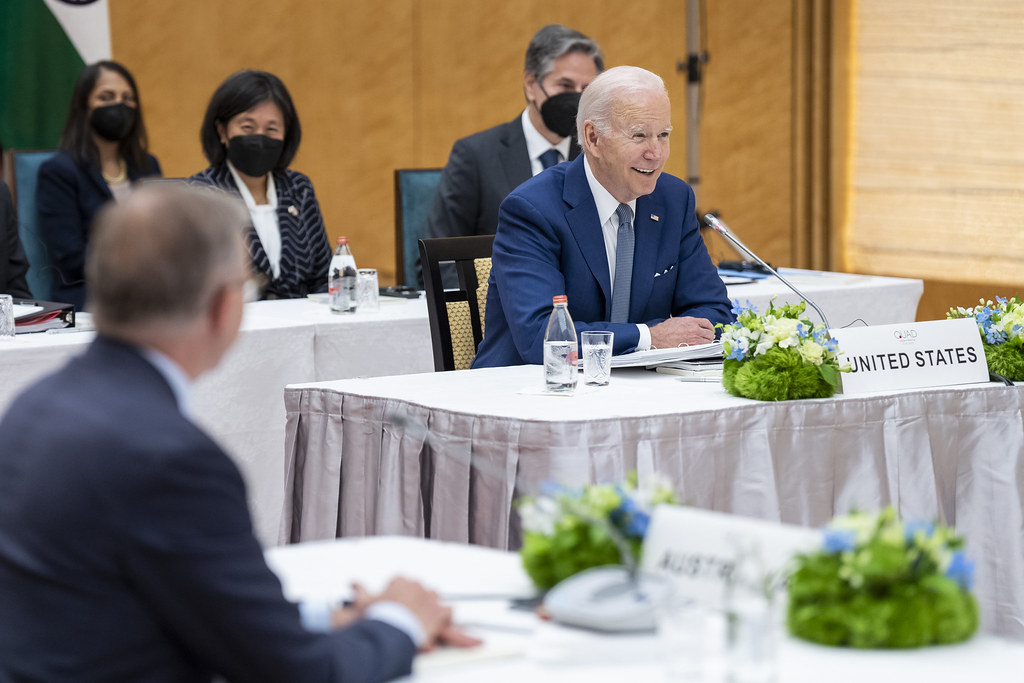Trading places
Stabilisation has been word of the month in Australia’s international economic relations as the Albanese government has sought to unravel the remaining Chinese trade impediments, despite challenges such as the naval friction off Japan.
But “diversification” is never far behind. And now thanks to the latest Australian Chamber of Commerce and Industry (ACCI) trade survey we have some tentative insights into just how this persistent government policy aim is playing out.
China has fallen from the top position in the list of trade partners for the first time in the six periodic surveys conducted since the bilateral trade agreement was being finalised in 2014, to be replaced by the United States. While the methodology and questions in these surveys do vary, back in 2016 and 2018 at least 60 per cent of businesses surveyed were trading with China. But now that is down to 43 per cent. The United States, on the other hand, has risen to 50 per cent from slightly below that in the pre-pandemic period.
(These figures measure the countries with which Australian companies are trading rather than the value of trade where China remains the largest export and import partner, although down on historic highs).
Back in 2018 there was a curious bifurcation under way which only emphasised the then growing dependence on China. It was relentlessly rising as a market but otherwise the survey noted that there was an apparent shift away from other high growth, emerging markets such as India and Indonesia back towards what were called the “culturally similarly advanced” markets of New Zealand, Singapore and the United States.
Now the latest survey report is emphasising diversification again, declaring: “This data confirms that Australia’s trade relations extend significantly beyond its current and prospective Free Trade Agreement partners, including in the Middle East, South Asia, Africa and South America.”
But, notwithstanding the China downturn, over the last five years this is still a mixed situation. New Zealand is down a lot as a market (at 38 per cent this year) and Singapore a bit (42 per cent) while along with the United States, the United Kingdom is up significantly (at 35 per cent) reflecting the relatively new bilateral trade deal.
The big diversifications, very much in line with government policy initiatives, are India and Vietnam. India, with a partial trade deal newly in place and a bigger one promised, is up from 25 per cent to 32 per cent. Meanwhile Vietnam, which didn’t even make the top 22 cut in 2018 is now at 29 per cent, reflecting at least in part the enhanced economic engagement program.
And with the government now focused on closer economic relations with broader Southeast Asia to 2040, Vietnam trade is doing all the heavy lifting so far. The rankings for Malaysia (35 per cent) and Thailand (31 per cent) are unchanged over five years while Singapore and Indonesia (26 per cent) are down.
To round out Asia and the top partners, Japan remains the fifth or sixth most popular trading partner with a consistent 35 per cent of businesses nominating it, while South Korea has risen a little to 26 per cent.
Perhaps the most curious feature of this survey is the rise of the United Arab Emirates as a partner to the point it is now the fifth “major market.” That gives some context to this week’s suggestion that the government is turning back to this corner of the world to revive a potential new trade agreement after the collapse of negotiations with the European Union.
(Non) Trader Joe
The rise of the United States as an offshore focus for Australian business may well reflect the prospects for economic recovery there and the Biden administration’s big spending industry policy in the so-called Inflation Reduction Act, as much as China’s coercive tactics.
But it unfortunately runs up against the reality on the ground last week as the administration’s ambitions to claim some greater credibility as trade partner in Asia wilted under pressure from the protectionist forces in its Congressional ranks. Not only did the administration drop the very modest trade pillar in its Indo-Pacific Economic Framework (IPEF) at the last minute during the Asia Pacific Economic Cooperation (APEC) group summit, but it also walked away from the long standing American position on promoting cross-border access to information in the World Trade Organisation (WTO) e-commerce negotiations.
IPEF is the Biden’s administration’s attempt to partly fill the void left behind in Asia by Donald Trump’s dumping of the once US-led Trans-Pacific Partnership. But it is little appreciated it was also Prime Minister Anthony Albanese’s inaugural international agreement – signed during his rushed trip to the Tokyo Quadrilateral Security Dialogue meeting days after the 2022 election.

The Australian budget released in May provided a little-reported allocation of $32 million so Australia could help persuade Asian members to stay in the latest American trade cart. Indeed, Albanese and Biden even doubled down on the IPEC idea again only last month in Washington when they committed to aligning it with Australia’s Southeast Asia Economic Strategy to 2040
So, it was quite striking that last Wednesday Trade minister Don Farrell was telling ABC radio from the APEC meeting: “It’s important that the United States engage in a trading relationship in our region. So, the document I signed today is the first of four pillars, and we are hoping to make significant progress on the remaining pillars over the next couple of days.”
But later the same day Ohio Democrat Senator Sherrod Brown was actually announcing the administration policy with his own media release saying: “I’ve made it very clear that the trade portion of the Indo-Pacific Economic Framework is unacceptable, and I’m glad it’s not moving forward. Instead of negotiating trade deals behind closed doors, we should be working to strengthen enforcement so that American workers can compete on a level playing field.”
The administration had already spent so much time playing down the prospect in Congress that IPEF would provide any trade access for Asian countries, that those same countries apparently didn’t feel the need to make the environment and labour changes the Democrats wanted. The three pillars that have been agreed are useful, but it seems doubtful that in an election year battle with Trump that the Biden White House will really take up the trade pillar again.
While Albanese now says three out of four is “doing pretty well”, a Jakarta Post editorial better captures the Asian mood:
The administration of Joe Biden, like that of Trump preceding it, prefers bilateral arrangements that keep all options open for it to curb trade whenever and wherever it sees fit … Such a transactional approach is unappealing to Asian economies looking for dependable, long-term trade relations … It is safe to conclude that, with the IPEF, we are not on the same page.
New threats, old concerns
The ACCI survey shows that Australian businesses are relatively attuned to the risk of global fragmentation after the experience with China, and perhaps the wilting of IPEF. Seventy-one per cent say that the need to diversify markets is a concern and 61 per cent identify geopolitical tensions as a concern. But only 55 per cent had increased marketing in new markets compared with 52 per cent sticking with marketing in existing markets and the same proportion focused on increasing sales in Australia.
And despite the geo-political turmoil of the past few years and discussion about a changed global economy, it is interesting to see what has or hasn’t changed in the practical concerns of the businesses which do the actual diversification. International competitiveness is the top concern this year as it was in 2018, but skills shortages have replaced the exchange rate as the second biggest concern over the five-year period of turmoil.
With trade pacts proliferating at both the bilateral (e.g.: the Australia-Singapore Green Economy Agreement in 2022) and the plurilateral (Regional Comprehensive Economic Partnership, also in 2022), the business feedback remains fairly consistent. Knowledge of agreements tends to be aligned with trade patterns and knowledge of the plurilaterals, much talked up by politicians at summits, tends to lag.
So, despite all the problems with China, that 2015 bilateral agreement remains the best known and most used trade avenue (out of 20 surveyed) as it was in 2018. The 2005 Thai and 2014 Korea agreements are the next most popular bilaterals in the latest survey compared with the 1983 New Zealand and 2005 United States agreements back in 2018, which is an interesting shift away from the “culturally similarly advanced” world.
But there is a striking cross-cutting trend in this part of the survey when the government is trying to juggle the generally accepted macro-economic virtues of plurilateral over bilateral agreements with the macro-diplomacy of closer relations with Southeast Asia. The recently updated 2010 ASEAN-Australia-New Zealand agreement rivals the China bilateral agreement for familiarity and usefulness across the five years.

